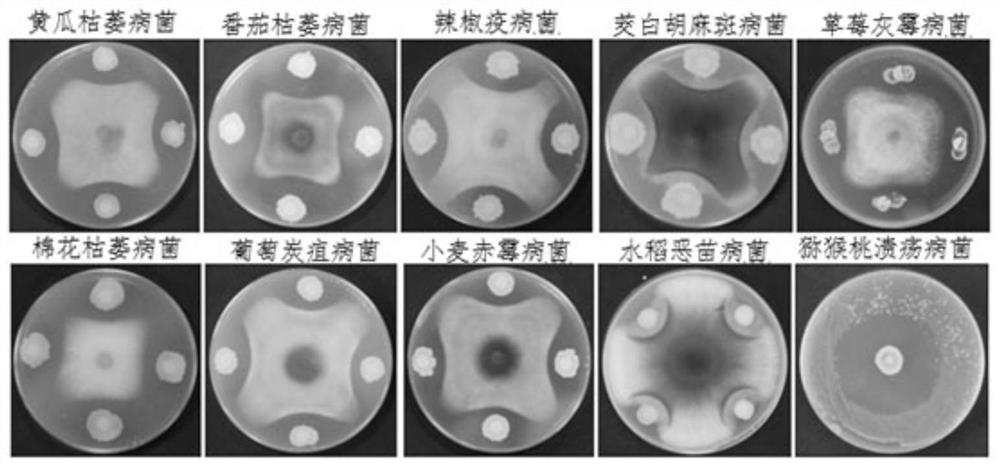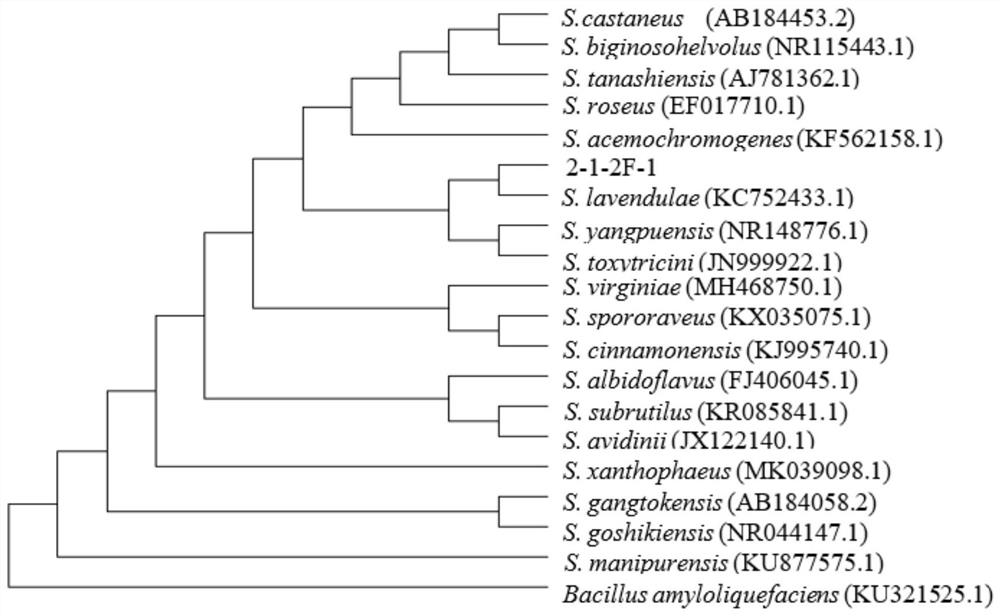Application of a strain of Streptomyces lilacinus 2-1-2f-1 and its antibacterial substances in the control of vegetable soil-borne diseases
A technology for Streptomyces lavender and soil-borne diseases, applied in pest control, microbial-based methods, chemicals for biological control, etc., can solve the problem of unsatisfactory prevention and control of vegetable soil-borne diseases No problem, achieve low cost, convenient operation and good effect
- Summary
- Abstract
- Description
- Claims
- Application Information
AI Technical Summary
Problems solved by technology
Method used
Image
Examples
Embodiment 1
[0039] Example 1: Isolation of actinomycetes with strong antagonistic activity against Fusarium wilt of cucumber and tomato.
[0040] Soil samples were randomly collected from all parts of Jiangsu. The sampling method was to shovel the top 5 cm soil layer, take 50 g of fresh soil samples, store them in fresh-keeping bags, and record the sampling location and date;
[0041] Take 0.5g soil sample and add 1mL of water, shake it to make a soil suspension, and dilute it in a gradient of 10 3 ~10 5 times, take 100 μl of the dilution solution and spread it on the plate, and incubate it in a 28°C incubator for 48 hours;
[0042] Pick a single colony, streak it on Gao's No. 1 medium, purify it, and save it for later use;
[0043] Taking cucumber and tomato Fusarium wilt as the target bacteria, the antagonistic activity of the isolated strains was determined by the confrontation culture method, and the antibacterial bandwidth was determined by culturing at 24 ℃ for 4-5 days. The result...
Embodiment 2
[0044] Example 2: Classification and identification of strain 2-1-2F-1
[0045] (1) Morphological characteristics of strain 2-1-2F-1
[0046] Strain 2-1-2F-1 grows well on Gao's No. 1 solid medium, and both aerial mycelium and basal mycelium grow abundantly ( figure 2 Middle A), the colonies are circular, concentric rings, the hyphae are powdery, and the marginal hyphae are radial and multi-branched. With the differentiation and maturation of spore filaments and spores, the aerial hyphae gradually change from white to lavender grey( figure 2 Middle B), the mycelium in the base is white at the initial stage, and gradually becomes milky yellow at the later stage, and does not produce soluble pigment ( figure 2 middle C). Strain 2-1-2F-1 was observed under an optical microscope, and it was found that the spore filaments coexisted with straight and spiral shapes, with multiple linear spore filaments. figure 2 Medium D-E); the spore surface is smooth, round to oval, beaded,...
Embodiment 3
[0053] Example 3: Properties and composition analysis of the antibiotic active substances produced by the strain 2-1-2F-1
[0054] Strain 2-1-2F-1 was fermented in No. 4 fermentation broth at 30°C and 180r / min for 5 days, centrifuged at 5000r / min for 20min, took the supernatant, and added 4 times the volume of -20°C pre-cooled to the supernatant. Acetone, mix by inversion, overnight. Centrifuge at 5000 r / min for 30 min at 4 °C, remove the supernatant, and air dry at 0 °C. They were reconstituted with organic solvents of different polarities, and it was found that the antibiotics were insoluble in organic solvents such as acetonitrile, methanol, n-butanol, ethyl acetate, chloroform and petroleum ether, except that they were slightly soluble in dimethyl sulfoxide, but could be completely dissolved. in water ( Figure 4 ). The antibacterial substance was dissolved with PBS of 1 / 100 of the original volume, and the antibacterial ability of the antibacterial active substance was ...
PUM
 Login to View More
Login to View More Abstract
Description
Claims
Application Information
 Login to View More
Login to View More - R&D Engineer
- R&D Manager
- IP Professional
- Industry Leading Data Capabilities
- Powerful AI technology
- Patent DNA Extraction
Browse by: Latest US Patents, China's latest patents, Technical Efficacy Thesaurus, Application Domain, Technology Topic, Popular Technical Reports.
© 2024 PatSnap. All rights reserved.Legal|Privacy policy|Modern Slavery Act Transparency Statement|Sitemap|About US| Contact US: help@patsnap.com










